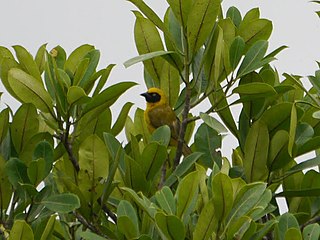
The conservation status of a group of organisms indicates whether the group still exists and how likely the group is to become extinct in the near future. Many factors are taken into account when assessing conservation status: not simply the number of individuals remaining, but the overall increase or decrease in the population over time, breeding success rates, and known threats. Various systems of conservation status exist and are in use at international, multi-country, national and local levels as well as for consumer use.

The giant sea bass is a fish native to the North Pacific Ocean. Although commonly referred to as a giant sea bass, black sea bass or giant black sea bass, it is actually a wreckfish in the family Polyprionidae rather than in the sea bass family Serranidae

Notiosorex cockrumi, also called Cockrum's gray shrew or Cockrum's desert shrew, is a tiny species of shrews named in 2003. This red-toothed shrew, which is as light as a penny, is the first new mammal species from Arizona since 1977. Its range extends from Arizona to central Sonora, Mexico.

Phayre's leaf monkey, also known as Phayre's langur, is a species of lutung native to South and Southeast Asia, namely India, Bangladesh and Myanmar. Populations from further east are now thought to belong to other species. It is listed as Endangered on the IUCN Red List and is threatened by hunting and loss of habitat. The species epithet commemorates Arthur Purves Phayre.

A species that is extinct in the wild (EW) is one that has been categorized by the International Union for Conservation of Nature as known only by living members kept in captivity or as a naturalized population outside its historic range due to massive habitat loss.
Mikania andrei is a species of flowering plant in the family Asteraceae. It is found only in Ecuador. Its natural habitat is subtropical or tropical moist montane forests. It is threatened by habitat loss.
Mikania chimborazensis is a species of flowering plant in the family Asteraceae. It is found only in Ecuador. Its natural habitat is subtropical or tropical moist montane forests. It is threatened by habitat loss.
Mikania cuencana is a species of flowering plant in the family Asteraceae. It is found only in Ecuador. Its natural habitat is subtropical or tropical moist montane forests. It is threatened by habitat loss.
Mikania harlingii is a species of flowering plant in the family Asteraceae. It is found only in Ecuador. Its natural habitats are subtropical or tropical moist montane forests and subtropical or tropical high-altitude shrubland. It is threatened by habitat loss.
Mikania iodotricha is a species of flowering plant in the family Asteraceae. It is found only in Ecuador. Its natural habitats are subtropical or tropical moist montane forests and subtropical or tropical high-altitude grassland. It is threatened by habitat loss.
Mikania iserniana is a species of flowering plant in the family Asteraceae. It is found only in Ecuador. Its natural habitat is subtropical or tropical moist lowland forests. It is threatened by habitat loss.
Mikania jamesonii is a species of flowering plant in the family Asteraceae. It is found only in Ecuador. Its natural habitat is subtropical or tropical moist montane forests. It is threatened by habitat loss.
Mikania millei, the poroto angu, is a species of flowering plant in the family Asteraceae. It is endemic to Ecuador. Its natural habitat is subtropical or tropical high-altitude grassland. It is threatened by habitat loss.
Mikania pulverulenta is a species of flowering plant in the family Asteraceae. It is found only in Ecuador. Its natural habitat is subtropical or tropical moist montane forests. It is threatened by habitat loss.
Mikania seemannii is a species of flowering plant in the family Asteraceae. It is found only in Ecuador. Its natural habitat is subtropical or tropical moist montane forests. It is threatened by habitat loss.
Mikania tafallana is a species of flowering plant in the family Asteraceae. It is found only in Ecuador. Its natural habitat is subtropical or tropical moist lowland forests. It is threatened by habitat loss.

Bannerman's weaver is a species of bird in the weaver family, Ploceidae. It is found in Cameroon and Nigeria. Its natural habitat is subtropical or tropical moist montane forests. It is threatened by habitat loss.

The Bornean water shrew is a species of mammal in the family Soricidae. It is endemic to Malaysia. Its natural habitat is rivers. It is threatened by habitat loss.

The Gau iguana is a species of iguana endemic to Gau Island in the Fijian archipelago. It mostly lives in the well-preserved upland forests of the island, with smaller populations in the degraded coastal forests. It can be distinguished from other South Pacific iguanas by the male's distinctive color pattern and solid green throat. It is also the smallest of all South Pacific iguanas, being about 13% smaller than the third smallest species and 40% smaller than the largest extant species.







